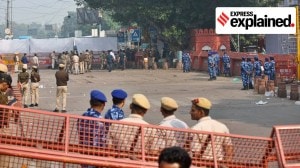How Bengal was won
Brand Buddha and the party combine to make CPI(M) the Left and Right choice

The staggering victory of the CPI(M)-led Left Front in West Bengal this week is remarkable for obvious reasons. No political party in the country, and possibly none in the world, has managed to secure the people’s mandate seven times in a row. For years together, opposition parties and the media had attributed the CPI(M)’s electoral success to “scientific rigging”. So shrill and sustained was that propaganda that even some Left sympathisers outside the state had begun to wonder whether there was, perhaps, an element of truth to that charge. The Election Commission, by singling out West Bengal for special treatment and enforcing the most strict monitoring mechanisms this time, has ended up doing a great service to the Left Front. By winning a three-fourths majority in an election that was widely regarded as the most “free and fair” poll ever held in the country, the CPI(M) has proved that its electoral victories are, and were, based on mass support.
But the real significance of the 2006 assembly elections — one that has important implications for political parties and governments across the country — lies elsewhere. It is that the Left Front has managed to get a renewed, and enhanced mandate, not because of the “reforms-friendly” policies pursued over the last five years but despite it.
Much has been made of the role of the ‘Buddha brand’ in this election. Buddhadeb Bhattacharjee’s success in wooing private investment, zeal in transforming Kolkata into a business-friendly metropolis and determination to make Bengal the most favoured destination for the IT sector and real estate entrepreneurs certainly struck a chord with the state’s business community and urban middle class. His can-do spirit also managed to imbue an infectious enthusiasm among a section of new voters who had grown up in an atmosphere of industrial decay and urban despair. The slight shift in the traditional anti-Left vote this time certainly helped the Left Front. But the Bengal story is much bigger than that.
Buddhadeb Bhattacharjee’s initiatives may have been new to West Bengal but they had been pursued by the Centre and other state governments for quite a while. Ever since the paradigm shift in the Indian economy in 1991, elected governments in India have followed neo-liberal economic policies of liberalisation, privatisation and globalisation. The Rao government’s policies were carried forward by the Vajpayee-led NDA dispensation. And with the Centre no longer dictating the pace of growth in the states, state governments began racing against one another to woo private domestic and foreign investment. Visible “feel good” signs — better urban infrastructure, sleek IT centres, and middle class consumerism — frequently followed.
But every leader who pushed this growth path — be he Narasimha Rao or Atal Bihari Vajpayee, N. Chandrababu Naidu or S.M. Krishna — lost at the hustings. If Bhattacharjee has bucked that trend, the secret of his success lies in the West Bengal CPI(M)’s very well thought-out and skilfully implemented strategy.
Despite ideological inhibitions against private capital, the Left Front government realised as early as 1994 that it was necessary for the economic growth of the state. Land reforms, decentralisation of power and government initiatives had yielded rich dividends in rural Bengal but industrial stagnation remained intractable. After 1991, it was no longer possible to blame the Centre’s “discrimination” for Bengal’s economic woes. Since providing “relief” to the people was the government’s priority, it was time to take advantage of the new economic policies and woo private investment. But it took several years for the LF to convince both private capital and sceptics within of the need to follow an investor-friendly policy.
The second part of the strategy was equally crucial. At the 2002 and 2005 West Bengal CPI(M) State Conferences, the key document — “Left Front Government and Our Tasks” — was discussed threadbare. The essence of the argument was that West Bengal, even under Left rule, could not remain isolated from the new economic framework unleashed by globalisation. But while that entailed a tactical reorientation in favour of private investment, the CPI(M) should not lose sight of its basic priorities and efforts to provide an alternative.
In practical terms, it meant that along with pro-privatisation initiatives, the state government must also pay greater attention to rural development. And the CPI(M) and its huge mass organisations would have to not only sustain but enhance their work among the Left’s traditional support base of industrial workers and peasantry — large sections of whom did not stand to benefit from the “Kolkata shining” glory.
Thus, wooing IT went hand in hand with unprecedented focus on primary education and preventive health care in the last five years. Thousands of women’s self-help groups (SHGs) were formed — one possible reason for the high turnout of women in this election that fuelled the CPI(M) sweep. And most important, CPI(M) cadres who famously work 365 days a year — election or no election — were entrusted to carry out “constant political education” to explain the apparent dichotomy between the state government’s “capitalist” policies and the party’s socialist objectives. The CPI(M)’s success in retaining seats in the industrial belt of Hooghly, Howrah, North and South 24 Parganas, and the Durgapur-Asansol belt — peopled by voters most affected by the decline of traditional industry — can be directly attributed to sustained party and CITU work in this area.
Since 1991, every government has tried to achieve the right mix between economic reforms and social welfare, between getting the support of the dominant elite and middle classes without alienating the urban and rural poor. But only the Left Front in West Bengal — at least for now — has managed it. The combination of Brand Buddha with a party organisation that has a deep and wide mass base enabled the CPI(M) to become — to rival constituencies — both the Left and the Right alternative, rendering the Congress and Trinamul Congress into vision-less non-entities.
The Congress-led UPA too harbours the same hope — to marry Manmohan Singh’s pro-reforms policies with the Sonia Gandhi-inspired “aam aadmi” initiatives. But India is not West Bengal and Congress is not the CPI(M). It might be a good idea for Rahul to intern with the Bengal CPI(M) for a year before he takes up the challenge of
reviving the Grand Old Party.
manini.chatterjeeexpressindia.com






- 01
- 02
- 03
- 04
- 05

























